Cookers and Stoves
FIRELESS COOKER
Where fuel is scarce, this easy-to-build fireless cooker can
be a contribution to
better cooking. It keeps food cooking with a small amount of
heat stored in hot
stones; loss of heat is prevented by
a thick layer of insulating material
around the pot.
Fireless cookers have been successfully
used in many countries. Once
the principle of operation, heat
retention through insulation, is
understood, the reader may develop
plans that are better suited to local
resources than those described
here. In some countries, fireless
cookers are built into the ground.
In others, they are built from
surplus tin cans, one can fitted
into another tin can or box but
separated by paper, sawdust, or
other layers of insulation.
Materials
Outside container with lid, 37.5cm to 60cm (15" to
24") in diameter
Inside container or well, at least 15cm (6") smaller in
diameter and 15cm (6")
shorter than outside container
Cooking pot with lid
Cloth for cushion, 1.2 square meters (1 1/2 square yards)
50 sheets newspaper or other insulation
Cardboard
Sand, .95 liter (4 cups)
Cement, .95 liter (4 cups)
Oilcloth for collar (optional), 0.4 square meters (1/2
square yard)
The outside container can be a wooden bucket, kerosene can,
garbage can, packing
crate, or even a hole in dry ground. The inside container or
well can be a
pail or can with a lid. It must allow for 7.5cm (3") of
insulation between it and
the outside container and should hold the stone and cooking
pot without much
vacant space.
Insulation can be made of shredded newspapers, wool cotton,
sawdust, straw,
rockwool, fiberglass, or other material. The insulation
should be at least 7.5cm
3") thick on all sides, top and bottom. Be sure that it
is very dry. The bottom
layer of insulation must be strong enough to support the
weight of the well,
stone, and cooking pot. A natural stone carved to shape or a
piece of concrete
may be used for the heating stone. The cushion is a cloth sack,
7.5cm (3") thick,
filled with shredded newspapers or other insulation. It
should fit snugly in the
outside container. The cooking pot must have a tight lid,
and fit nicely into the
well when the stone is in place. Be sure it can be removed
easily when full of
hot food.
Making the Fireless Cooker (See Figure 1)
fg1x353.gif (600x600)
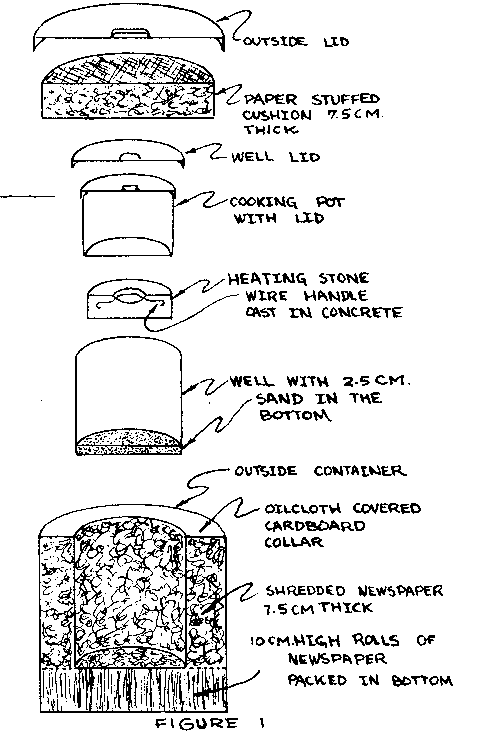
Wash and dry the containers and lids.
Cut 10cm-wide strips of newspaper several layers thick. Roll
each into a cylinder
with a center hole no greater in diameter than a pencil.
Pack these on end into
the bottom of the outside container. They will support the
well, stone, and pot.
Put the well in place. Pack insulation around it to within
1cm (1/2") of the top.
Make a cardboard collar covered with oilcloth. Though this
is not necessary, it
improves appearance and cleanliness.
Place about 2.5cm (1") of clean sand in the bottom of
the well. This will prevent
the hot stone from scorching the paper rolls and possibly
causing a fire.
To make a concrete heating stone, place a 5cm-wide cardboard
band or collar on
heavy paper or board to form a circle the size of the stone
desired. Mix .95 liter
(4 cups) each of cement and sand (the sand should first be
washed free of silt);
then mix in enough water (about .35 liter or 1 1/2 cups) to
form a stiff mush.
Fill the collar, casting in a wire handle for lifting the
hot stone. Let the stone
stand for 48 hours, then remove the collar, place it in cold
water, and boil for 30
minutes. Cool it slowly.
Using the Fireless Cooker
It is important to keep the cooking pot and well carefully
washed and open, in
the sunshine if possible, when not in use. The cooker's lid
should be left partly
open and the stone kept clean and dry.
It is not necessary to use much water when cooking in a
fireless cooker for there
is little loss by evaporation. Most foods should be brought
to a boil and cooked
for 4 to 5 minutes on another stove. The heating stone is
heated and placed in
the cooker. Then the covered cooking pot is set on the hot
stone in the cooker
and the lid is placed on the well. Cereal may be left in the
cooker all night. Rice
and cracked or whole wheat are especially good. Beans should
be soaked over
night, boiled for 5 minutes and then placed in the cooker
for 4 to 5 hours. Dried
fruit should be washed, soaked for an hour in 2 parts water
to 1 part fruit,
boiled for 5 minutes, then placed in the cooker for 4 hours.
Source:
Home Making Around the World, Washington, D.C.: U.S. Agency
for International
Development, 1963.
CHARCOAL OVEN
This simple charcoal-fired oven is made from two 5-gallon
oil tin cans. With
practice, all types of baking and roasting can be done
effectively.
Tools and Materials
Tin snips
Heavy knife
Nail for scriber and punch
Hammer
Screwdriver
Pliers
Bricks and sand
Metal bar, 20cm (7 5/8") long with
square edge for bending tin
5-gallon cans (2)
Tin (for shelf, top strip, and latch)
Light rod, 50cm (19 5/8") long
Light hinges with bolts (2 pairs)
Stove bolts, 5mm x 13mm (3/16" x
1/2") (15)
How To Build the Charcoal Oven
Mark the two 5-gallon cans for cutting (see Figure 2),
making sure that the
fg2x356.gif (540x540)
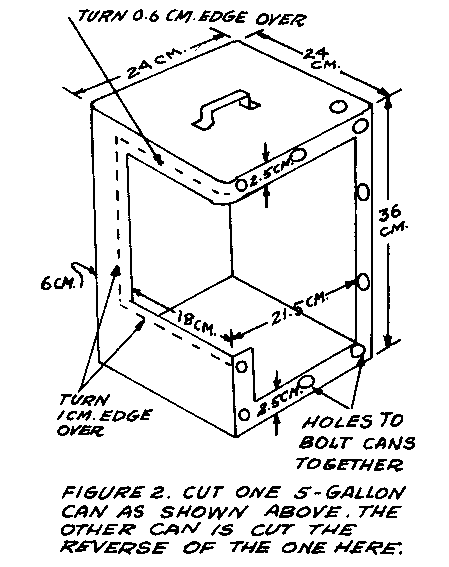
second can is marked the reverse of the first. Do not cut
the corner that has a
vertical seam: Besides being hard to cut, the seam will
strengthen the oven. The
material removed will be easier to make into doors if it is
seamless.
Cut along the marks with a heavy
knife, keeping the cut-out sections
as undamaged as possible. Fold the
edges of the oven-door openings
back 1cm (3/8") (see Figure 2).
With the nail, punch 5mm (3/16")
holes around the opening in the
side of the can to be used for the
left hand section of the oven (see
Figure 2). Place the second can
against the one just punched and
mark the holes with the nail. Punch
holes in the second can. Bolt the
cans together, using 10 stove bolts.
Flatten sections cut from cans and mark for doors (see
Figure 3). Using the tin
fg3x356.gif (486x486)
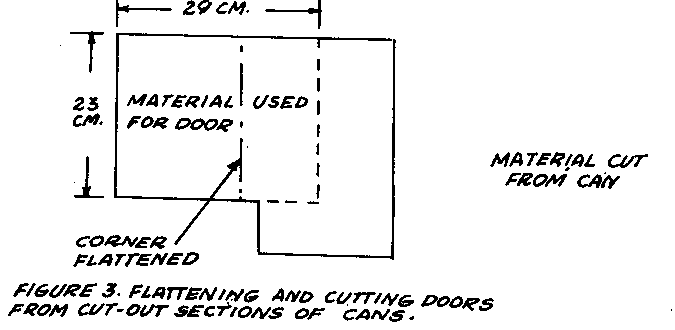
snips, cut doors to size and fold back the 1cm (3/8")
edge (see Figure 4). Position
fg4x356.gif (437x437)
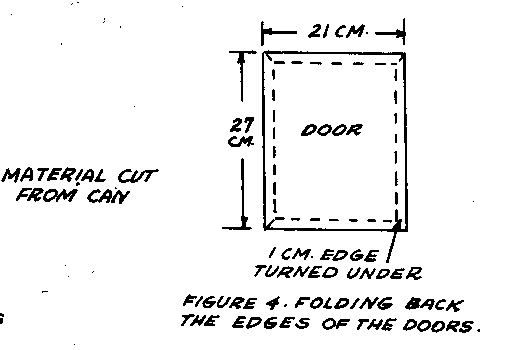
doors as shown in Figure 1, butting the edge of each door
against the edge of
fg1x355.gif (600x600)
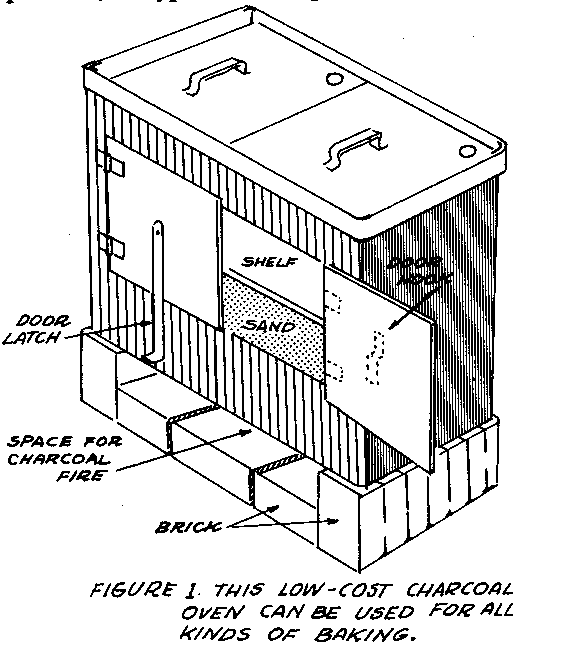
the opening to which it will be attached. Install hinges.
The door latch (see Figure 1) is made by folding a 6cm x
38cm (2 3/8" x 15")
strip three times lengthwise, forming a piece 2cm
(3/4") wide. An 8cm (3 1/4")
piece is cut from the end of the folded strip to form
hook--which is then bolted
(use 2 bolts) to the center of the door on the right. The
30cm (11 3/4") piece is
bolted loosely to the center of the door on the left. The
unattached end is bent
up to form a handle.
A triangular-shaped hole at the top of the doors where the
two cans come
together must be plugged to keep heat from escaping. This
can be done by
shaping a small piece of tin to fit the opening, with a tail
that is inserted
between the joined cans to hold it in place.
Construct shelf as shown in Figure 5 and install (see Figure
1). The shelf should
fg5x357.gif (437x437)
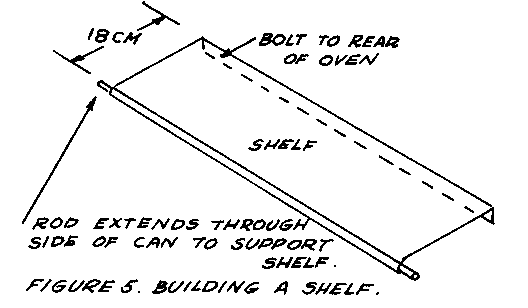
be bolted in place 15cm (5 7/8") from the floor of the
oven (see Figure 5).
The oven should be cleaned
thoroughly and heated at least once
before use to burn out any
remaining oil in the cans.
How to Use the Charcoal Oven
Place 1cm (3/8") of sand in the bottom of the oven and
place the oven on bricks
as in Figure 1. The oven can be removed until the charcoal
starts to burn, then
put in place.
A little time is required before the proper temperature is
reached because the
sand must first absorb and dissipate the heat. For very high
baking temperatures,
or to brown the top surface of baked goods, additional
pieces of charcoal can be
placed on top of the oven. An extra rim can be added to the
top edge of cans
for this purpose (see Figure 1).
Sources:
V.C. Pettit, United States Agency for International
Development
Dale Fritz, VITA Volunteer, Schenectady, New York
PORTABLE METAL COOKSTOVES
Loss of forest cover is a serious problem around the world,
particularly in
developing countries. In some of these countries, forest
cover has decreased from
over 60 percent to under 20 percent in just a few decades.
One consequence of
this loss of wood supply is that it is becoming increasingly
difficult for people in
these areas to obtain fuel to cook their food.
Improving the fuel efficiency of cookstoves is one way to
reduce the drain on
forests and the wood supply. Improved stoves can also reduce
the cost of cooking
fuel--an expense that consumes up to one third of the income
for some families.
Principles of Energy-Efficient Stoves
Traditional stoves are generally of three types. The
simplest is the three-stone
design, where the cooking pot rests on stones over an open
fire. The second type
is the massive stove, made of clay and sand, that may hold
several cook pots, but
which takes a long time and much fuel to heat up. The third
type is the lightweight
portable stove made of sheet metal or ceramic.
The traditional portable stove has been studied intensively
and modified to
achieve a very high level of efficiency--40 to 50 percent,
or more than twice the
efficiency of traditional stoves. In addition, the portable
stoves are easily mass
produced by local artisans and find a ready market alongside
more traditional
goods.
In a stove, heat is transferred from the fire to the pot by
the convective heat
process. To get the most convective heat transfer--and hence
fuel efficiency--it is
necessary to pass the hot gases
from the fire over as much of the
surface of the cook pot as possible,
and through as narrow a channel as
possible (see Figure 1).
fg1x358.gif (393x486)
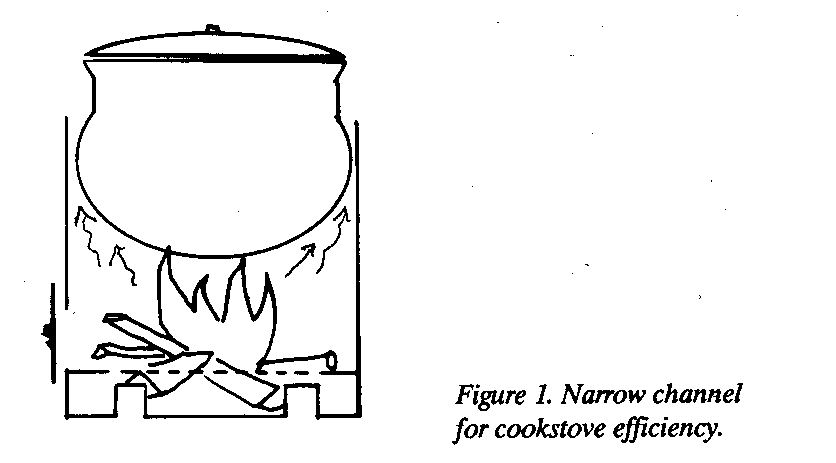
Narrower channels give higher convective heat transfer
efficiencies, and thus
reduce the overall size of the fire needed for cooking. But
if the channel is too
narrow, the fire may be choked off, and either smoke or die.
Experimental work
has shown that a channel between 4mm and 8mm wide (about 1/4
inch) is best.
If families already have their cook pots, then the stove(s)
must be designed and
built to fit the cook pots in order to obtain the narrow
channels for the hot
gases from the fire. This means that one should not design
and build the cookstoves
until the sizes of the cook pots have been measured. An
alternative is to
design a cookstove that can be efficient with a variety of
pot sizes, using a
selection of inserts provided with the stove so that the
channel can be just right
for a variety of pot diameters. It is recommended that a
survey be made of the
pot diameters in common use in the local area before the
cookstove design is
made final.
In order to sell fuel-efficient cookstoves, local artisans
must not only be able to
produce them, but people must want to buy them and must have
the means to do
so. In addition to determining the usual cook pot size in
the market area, it is
useful to ask potential customers what they want in a
cookstove and how much
they think they would be willing to pay. Market surveys in
some countries show
most people want a stove that can cook food quickly and use
less fuel. The
selling price of the stove described below is approximately
US$3.00 (1987) in one
West African country, a price people were willing to pay.
Cookstove Design
If you plan to make more than one or two cookstoves, it is
best to make templates
(patterns) for the stove parts first. The templates shown in
Figures 2, 3, and 4
fg2x3590.gif (486x486)
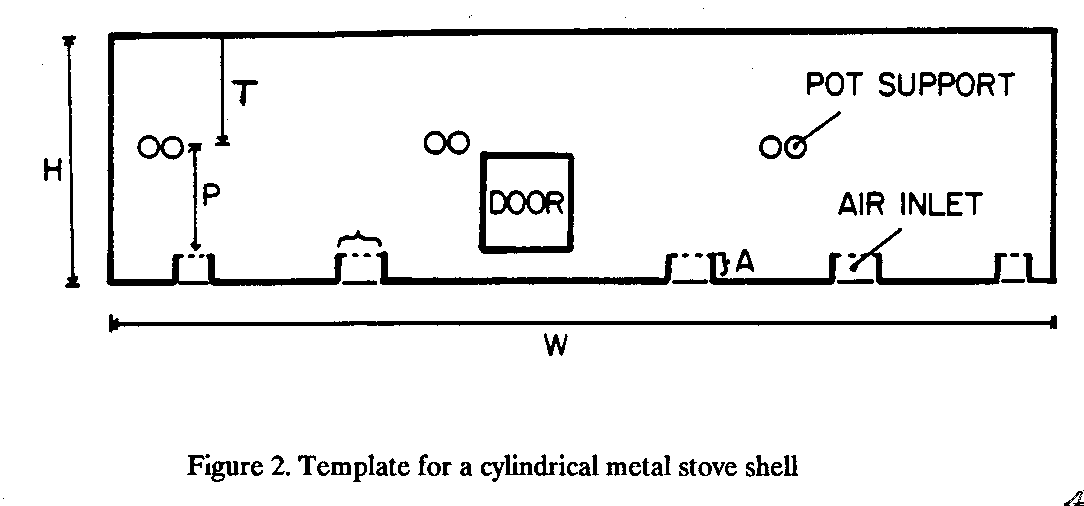
will produce stoves suitable for spherical or cylindrical
cook pots. Templates
may be made of cardboard, plywood, or, better yet, sheet
metal.
The stove presented here requires some welding and the use
of concrete reinforcing
rod (re-rod) as the pot support. Other designs, equally
efficient, may use
rivets or hammered seams and pot supports made of the same
material as the
stove.
1. The length of
the template is given by
L = C + G + S + T
C is determined
by the measure of the pot around its widest circumference.
G is determined
by the desired pot-to-wall gap, G = 2pi. For a gap of 4 mm,
G = 2.5 cm; for
6 mm, G = 3.8; for 8 mm, G = 5.0 cm. A gap of four to six
mm
(3/16-1/4") is preferred. Increase it only if excessive smoke comes out
the door or the
heating rate is too slow. S is determined by the amount of
overlap in the
seam. It is preferable to weld the stove together end to end
(thus S = 0) to
prevent the creation of a small vertical channel by which
the heat can
by-pass the pot. If the seam is crosswelded or folded, typical
values for S
will be 1 cm. T is determined by the thickness of the metal
used. One
typically uses 1 mm (T = 0.3 cm) or 1.5 mm (T = 0.47 cm) thick
metal. Thus, for
a 90 cm circumference pot, a 4 mm gap, an end-to-end
welded seam, and
1 mm thick metal we find:
L = 90 + 2.5 + 03 = 92.8 cm
2. For spherical
pots, template height H is determined by the sum of the
airhole height
(A), the grate-to-pot height (P), and the amount necessary to
extend a few
centimeters above the pot's maximum circumference when in
place on the
stove (T).
H = A + P + T
Typical values
for A are 3 cm (1 13/16") and for P 0.4 of the pot diameter.
For cylindrical
pots the height T is typically 5 to 10 cm (2 to 4"). The best
height T is
determined more precisely by comparing the increased efficiency
and reduced fuel
use caused by the additional height versus the increased
cost of the
extra metal. Additional height can also be provided at the top
and bottom of
the template, typically 1 cm (3/8") each, to allow the edge to
be folded over
to protect against sharp edges and increase the stove's
rigidity and
strength.
3. Stoves usually
have four air holes, about 3 cm by 3 cm (1 13/16" by 1
13/16")
each (A = 3 cm). Space them symmetrically, but far enough away
from the door
and the seams to avoid weakening the stove. Cut the airholes
on two sides
only so that when bent upward and inward they can act as
supports for the
grate. for larger pots or soft soil where the stove will sink
in, larger
airholes may be necessary. Alternatively, for soft soil conditions a
ring-shaped
platform can be cut and attached to the stove.
4. Space pot
supports evenly around the stove, but offset from the door and
edges so as not
to weaken them. The height P for the pot supports above
the top of the
air holes (where the rate will rest) is given roughly by
P = 0.4C/pi or 0.4D
where D is the
pot diameter. The best distance will vary somewhat with the
size of wood
used locally, its moisture content, and other factors.
5. The door size is
somewhat arbitrary and is determined by the locally
available wood
size. Typical sizes for a 90 cm (35") circumference pot are 12
cm wide by 9 cm
high (4 3/4" x 3 1/2"). Place the bottom of the door at the
grate
position-the top of the air holes. Make the top of the door several
centimeters
below the bottom of the pot so that the hot gases are guided up
around the pot
rather than out the door. If necessary, decrease the door
height to ensure
that it is below the bottom of the pot.
6. The grate is a
circle of sheet
metal cut to fit
snugly into
the finished
cylinder. Punch
the center
diameter with a 30
percent hole density of 1 cm
(3/8")
holes.
Producing the Cookstoves
The stoves can be produced in villages in nearly all
countries by metal working
artisans with modest skills.
Tools and Materials
Sheet metal shears
Ball-peen hammer
Hole punch
Anvil
Welder
Sheet metal, approx. 1 mm (.04") thick (2 to 3 stoves
per sq. meter)
Heavy wire (for handle)
Heat resistant paint (optional)
To produce stoves in quantity:
o Trace the
template on a sheet of metal as many times as desired or as space
permits.
o Cut each form
out in outline. Cut the door, pot support holes, and strips for
the airholes.
o Roll the metal
into a cylinder. The cylinder should be as straight and smooth
as possible.
o Cut out other
components such as pot supports and stabilizers and put them
into place.
o Cut the grate
and punch the holes in it.
o Weld the stove
together. Weld pot supports into place. Alternatively, fold all
seams together.
Hammer smooth.
o Place the grate
in the stove, fold the tabs from the airholes inward and
upward.
o Paint it with
heat resistant paint where available.
o Add wire loop if
desired to lift stove.
The finished stoves are shown in Figures 5 and 6.
fg5x3620.gif (437x437)
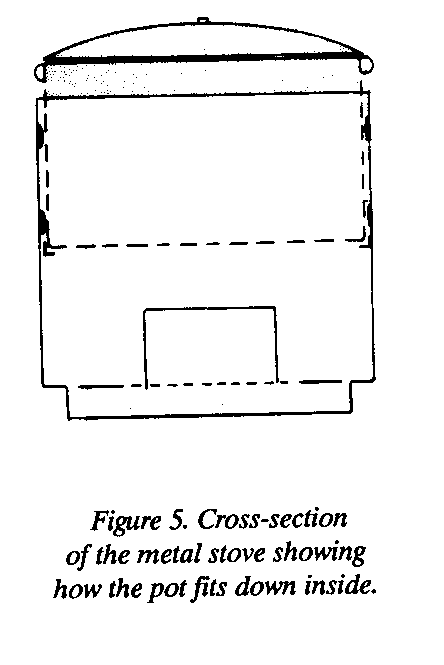
Source: Sam Baldwin, VITA Volunteer, Princeton, New Jersey.
OUTDOOR OVEN
An outdoor oven is easy to build and good for baking bread,
potatoes, beans,
cereals, cakes, and other foods.
Tools and Materials
Adobe blocks or brick: 35cm x 25cm x 10cm (14" x
10" x 4")
Wood or metal for door and smoke hole covers
Clay or cement for plastering
Lay bricks on the ground to make a base, 120cm x 120cm
square and 30cm high
(4' x 4' x 1'), on which to build the oven. After making the
base, build the oven
walls in an oval shape as shown in Figures 1 and 2. Lay the
bricks flat and
fg1x3630.gif (437x437)
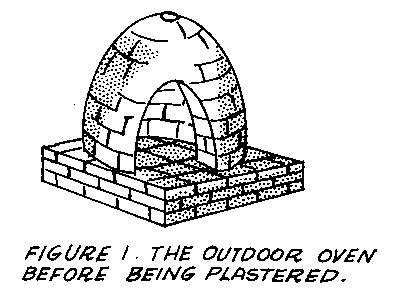
lengthwise starting from each side of the door opening,
using the center of the
square base as a guide. To form the dome shape and oval door
opening, cut the
corners of the bricks as you lay them. The inside space
should be about 75cm
(30") in diameter and 90cm (3') high. Leave a front
opening for the oven door and
a small opening at the top to let the smoke escape (see
Figure 2).
fg2x363.gif (437x437)
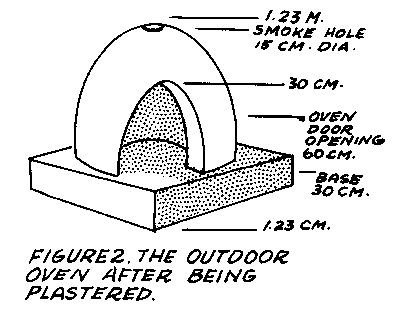
Now make wooden or metal covers to fit tightly over the door
opening and the
smoke-hole (see Figure 3). These should be tight-fitting so
that hot air will not
fg3x363.gif (393x353)
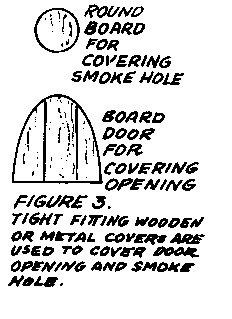
leave the oven when the openings are closed.
Plaster the inside and outside with a clay mixture or
cement. The stove should be
re-plastered at least once a year.
With the door and smoke-hole open, build a fire in the oven.
When the fire has burned to ashes, sweep out the ashes.
Put the food to be cooked inside the oven. Use trays or be
sure the oven floor is
very clean.
Cover the door opening and smokehole tightly.
Experience will teach how long food should be cooked. Bread,
for example, can be
expected to take an hour to an hour and a half.
This type of oven was used traditionally in many areas of
Europe, the southwestern
United States, and in villages throughout South Asia.
Source:
Home Making Around the World Washington, D.C.: U.S. Agency
for International
Development.

